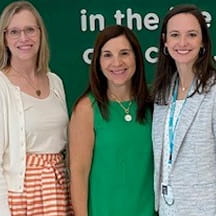Clinical Coaching Algorithm Helps Educators Guide New Graduate Nurses to Improved Clinical Judgment

Clinical judgment in new graduate nurses
Since 2015, pass rates for the National Council Licensure Examination (NCLEX) have remained between 80-90%, while results from the Performance-Based Development System Exam (PBDS), which evaluates clinician competency and helps ensure quality patient care, showed a steady decline in new graduate nurses’ clinical judgment upon entering practice during the same timeframe.
In a webinar hosted by Pediatric Learning Solutions, Mary Anne Jessee, Ph.D., RN, associate professor, assistant dean for academics, generalist nursing practice, Vanderbilt University School of Nursing, shared background on this growing challenge for children’s hospitals and an algorithm that can be implemented at the organizational level to help educators, preceptors and supervisors foster clinical judgment in newly graduated nurses.
Jessee said several terms are used interchangeably across industries and practices to describe the same set of skills, but these terms have different definitions as they apply to nursing:
- Critical thinking. Purposeful, self-regulatory judgment including interpretation, analysis, evaluation and inference.
- Clinical reasoning. Complex cognitive and metacognitive process to gather, analyze and evaluate domain-specific patient data in the context of background and experience.
- Clinical judgment. Interpretation or conclusions about a patient’s needs and decisions on what actions to take.
Preferring the clinical judgment terminology, Jessee described it in two ways, “[First], as the conclusion or the decision that is made as a result of the clinical reasoning process. [Second], it is described as a combination process that incorporates clinical reasoning,” she explained. “It’s the all-encompassing reasoning processes that we use and the decisions that we make in clinical practice as a result.”
A nurses’ lack of clinical judgment can result in errors in patient care, declines in patient status, delayed or missed care and declines in patient satisfaction.
“So, what will we do about this? We have to do something. It is our responsibility,” Jessee said. “It’s important to think about what your ‘why’ is. My ‘why’ is that all of humankind deserves the highest quality nursing care from clinicians who value their patients’ uniqueness and personhood. I foster student, clinician and educator passion for safe quality care, and I do that by teaching them to assess and develop clinical reasoning and judgment.”
An industry challenge reliant on local solutions
Contributing factors to the decline in clinical judgment abilities in new nurses are vast, and researchers speculate that factors include increased complexity of patients, including multiple comorbidities and less hands-on learning opportunities in nursing schools as a result of the COVID-19 pandemic. High rates of turnover, burnout and expectations that nurses manage more patients per shift than in the past also play a part.
While efforts such as adding clinical judgment measurements to the NCLEX exam in 2023 through case-based questions in addition to more traditional questions are being made on an industry level to help correct this trend, Jessee said that locally—through each hospital, unit and learner—is the most direct way to help patients and the recent graduates caring for them.
On an individual level, challenges with clinical judgment are a combination of each nurse’s experience, confidence and the complexity of the practice each person is expected to perform. These challenges are best addressed as individually as possible to see ideal results.
Jessee created an algorithm designed to help nurse educators guide new nurses through the process of developing these skills, with three steps: questioning, teaching and feedback.
Questioning
Asking questions first allows learners to share their knowledge and thought processes and gives educators an opportunity to guide them in connecting critical pieces of information to make decisions in the best interest of their patients. Jessee included three question steps in the algorithm.
- Start broad. Asking open questions, such as “What do you notice from this information, and what should we do?” allows educators to assess a learner’s ability to identify important pieces of data, consider all aspects of a situation and identify deficits where clinical judgment skills could be improved.
- Narrow the scope. Asking more specific questions, such as “What do these lab values mean in context of the diagnosis?” allows the learner to deepen their thought process and identify unexpected findings and relationships between individual situations and their knowledge base.
- Back to basics. After learners have explored deeper connections in their knowledge base, Jessee suggests returning to a higher level, but asking more detailed questions than in the “start broad” category. This allows educators to identify if the student knows the expected finding (or correct answer) and is able to recognize the difference between expected and abnormal patient findings. This can determine whether they should return back to broader questions or move on to the next step in the algorithm.
Teaching
If, after working through the three levels of questions, a learner is still not reaching the correct conclusion to provide safe care, moving to teaching ensures patient safety and fosters continued learning opportunities for the new nurse.
Jessee split teaching into categories:
- Types of teaching include modeling, explaining, providing rationale and giving instructions about what to do. Modeling and explaining provide the most learning opportunities.
- The amount of teaching needed is a balance between:
- Just enough, which gets the learner to the next step in the reasoning process but challenges them to think.
- Not enough, which slows and reduces the safety of care delivery.
- Too much, which limits their thinking and improvement of clinical judgment.
“Simply giving instructions about what to do creates a missed opportunity to provide crucial teaching in the moment to get that learner to the next step in the reasoning process,” Jessee said. “Provide just enough teaching to move their thinking forward and maintain patient safety.”
Feedback
“Sometimes even your teaching doesn’t get the learner on the right path. If that occurs, you need to do whatever it takes to ensure safe care delivery,” Jessee said. “When we provide feedback to learners, we need to make sure it’s supportive so that learners are able to open up about their deficits, their fears and their lack of confidence.”
Both verbal and written feedback are valuable in guiding learners through the clinical judgment process and documenting progress, Jessee advised.
Verbal feedback should be provided during clinical coaching and in-the-moment opportunities or immediately after clinical situations. Keeping this very specific, focused on the situation and narrowing to specific positive reinforcement as well as needs for improvement to maintain patient safety ensures learners are given the most important information to reflect on.
Written feedback should be completed as soon after clinical situations as possible. Providing factual documentation of strengths, successes, unsafe actions and areas for improvement, as well as specific instructions for remediation, reflection and other activities to guide improvement are helpful in outlining the next steps in the learning process. Requiring learners to complete a written reflection and response to these instructions allows for both documentation and evaluation of the effectiveness of the learning experience.
Jessee stressed that in order to be impactful, feedback should be supportive (encouraging self-efficacy), specific (in praise, how to improve and expectations for change) and timely (while the experience is still fresh in the learner’s mind).
“In summary, [an educator’s] role in continuing the learner’s development of clinical judgment may directly influence patient outcomes. A simple strategy, such as this clinical coaching algorithm, helps to standardize assessment and the development of clinicians’ clinical judgment.”
About PLS
Pediatric Learning Solutions’ online education provides the foundational knowledge clinicians need to master the competencies and skills for safe and effective patient care.


